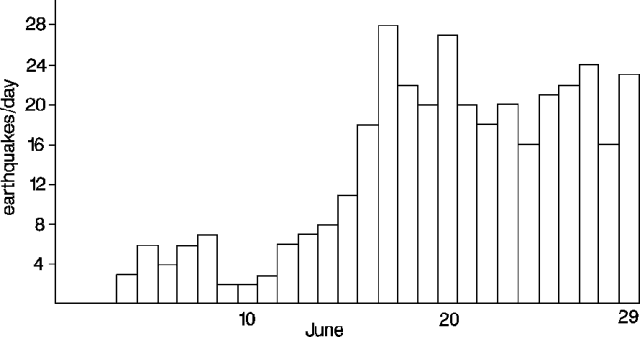Report on Arenal (Costa Rica) — June 1990
Bulletin of the Global Volcanism Network, vol. 15, no. 6 (June 1990)
Managing Editor: Lindsay McClelland.
Arenal (Costa Rica) Pyroclastic activity resumes after brief pause; lava flows
Please cite this report as:
Global Volcanism Program, 1990. Report on Arenal (Costa Rica) (McClelland, L., ed.). Bulletin of the Global Volcanism Network, 15:6. Smithsonian Institution. https://doi.org/10.5479/si.GVP.BGVN199006-345033
Arenal
Costa Rica
10.463°N, 84.703°W; summit elev. 1670 m
All times are local (unless otherwise noted)
Strombolian activity and lava emission continued during the end of May and through the end of June. Three new lava flows were noted on 6 June, extending as much as 300 m from the active crater's S rim; one flow was still advancing a few meters/day. Several older lava flows continued to advance, and the NW lava flow continued to build a delta in the southern headwaters of the Rio Tabacón, roughly 1 km from the summit. This and other flows are continuing sources of small block and ash flows.
A cessation of pyroclastic activity, similar to that of July 1989, lasted from 28 May to 16 June. The resumption of pyroclastic activity was preceded by an increase in seismicity (figure 28) and accompanied by a moderate increase in tremor. The number of earthquakes/day peaked on 17 June. The renewed pyroclastic activity included Strombolian explosions, sometimes intense, that occurred every hour to few hours, ejecting blocks to several hundred meters height. The explosions were accompanied by other pyroclastic events, identified by sound characteristics as intense gas, block, and bomb fountains, or less intense emissions of the same components. On 21 June around 1900, a particularly intense episode of fountaining was observed.
Geological Summary. Conical Volcán Arenal is the youngest stratovolcano in Costa Rica and one of its most active. The 1670-m-high andesitic volcano towers above the eastern shores of Lake Arenal, which has been enlarged by a hydroelectric project. Arenal lies along a volcanic chain that has migrated to the NW from the late-Pleistocene Los Perdidos lava domes through the Pleistocene-to-Holocene Chato volcano, which contains a 500-m-wide, lake-filled summit crater. The earliest known eruptions of Arenal took place about 7000 years ago, and it was active concurrently with Cerro Chato until the activity of Chato ended about 3500 years ago. Growth of Arenal has been characterized by periodic major explosive eruptions at several-hundred-year intervals and periods of lava effusion that armor the cone. An eruptive period that began with a major explosive eruption in 1968 ended in December 2010; continuous explosive activity accompanied by slow lava effusion and the occasional emission of pyroclastic flows characterized the eruption from vents at the summit and on the upper western flank.
Information Contacts: W. Melson, SI; G. Soto and R. Barquero, ICE.


